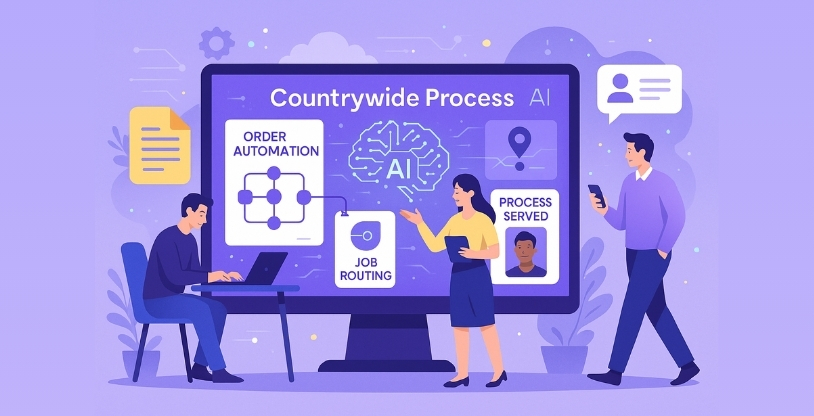
Countrywide Process
November 26, 2025
As we reach the end of 2025, the legal industry stands at the edge of another major shift. Digital transformation has accelerated in every area of law—from eFiling to court integrations—and service of process is no exception.
But 2026 will take things even further.
Automation, artificial intelligence, and nationwide compliance technology are evolving rapidly, turning what used to be slow, manual tasks into streamlined, error-proof workflows. For law firms, legal departments, and support professionals, the next year represents an opportunity to work faster, smarter, and with far greater accuracy.
Here’s what to expect in 2026 and how service of process automation will transform the way legal teams operate.
Over the last few years, counties and courts across the United States have dramatically increased their digital readiness. As more jurisdictions adopt eRecording, eFiling, and digital access systems, service of process is naturally moving toward total automation.
Three major forces are driving the shift going into 2026:
The result is a perfect environment for automation to become the new industry standard.
2025 was a year of rapid maturity in legal technology:
These advancements laid the groundwork for even more impactful technology coming in 2026.
In 2026, most large and mid-sized firms will rely on automated routing systems that:
This means faster turnaround, fewer wasted attempts, and more predictable timelines.
The demand for real-time visibility is increasing, and in 2026, automation platforms will deliver:
Clients will expect this transparency, and manual updates will quickly become obsolete.
2026 will push consolidation. Instead of multiple systems for:
Firms will adopt centralized dashboards integrating all services in one place.
Automation will seamlessly connect these workflows, reducing errors and administrative time.
One of the biggest pain points in 2025 was document rejection.
But in 2026, AI-powered compliance tools will:
This will drastically cut down resubmissions and delays.
Large Language Models (LLMs) will help legal professionals by:
This will strengthen both accuracy and efficiency for document-heavy workflows.
The impact will be significant:
Automation doesn’t just speed up the process—it makes every step more reliable.
As 2026 approaches, legal service companies must:
Clients will expect modern, efficient, transparent service supported by cutting-edge technology.
Countrywide Process already aligns with the industry’s 2026 direction through:
As automation becomes essential, Countrywide Process is ready to lead the transition—helping law firms streamline operations with reliability, speed, and compliance.
2026 will be the year service of process automation becomes not just beneficial, but essential.
The firms and providers that embrace automation will gain speed, accuracy, efficiency, and better outcomes for their clients.
The future is faster, smarter, and more connected.
And Countrywide Process is prepared to guide the legal industry into that future.
It uses AI and digital tools to streamline service attempts, routing, tracking, and compliance.
Because courts and counties are moving to fully digital systems, making manual processes slower and riskier.
AI assigns servers, predicts success, optimizes routes, and detects issues before they cause rejections.
Yes. It flags missing information, formatting issues, mismatched names, and notarial errors before submission.
It gives instant visibility into attempts, timestamps, GPS data, and progress—no waiting for updates.
No. It enhances their work by providing better tools, routes, and accuracy improvements
Predictive routing uses AI and historical data to choose the fastest and most effective path for a successful serve.
Automation follows county and state rules automatically and flags errors before filing.
It reduces admin time, speeds up service, improves accuracy, and increases process transparency.
We offer nationwide coverage, AI-supported tools, real-time tracking, and processes designed to reduce rejections.